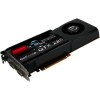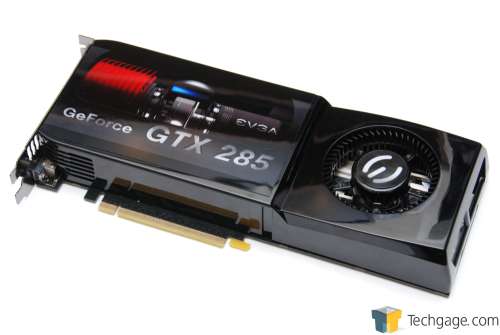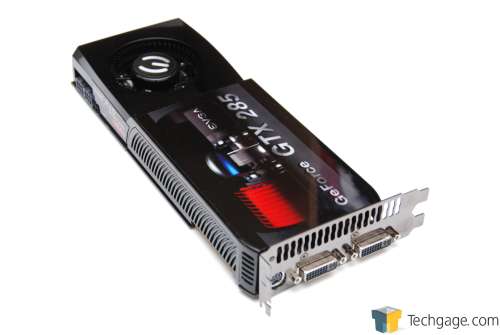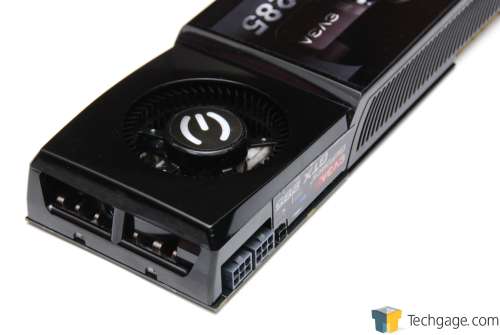- Qualcomm Launches Snapdragon 4 Gen 2 Mobile Platform
- AMD Launches Ryzen PRO 7000 Series Mobile & Desktop Platform
- Intel Launches Sleek Single-Slot Arc Pro A60 Workstation Graphics Card
- NVIDIA Announces Latest Ada Lovelace Additions: GeForce RTX 4060 Ti & RTX 4060
- Maxon Redshift With AMD Radeon GPU Rendering Support Now Available
EVGA GeForce GTX 285 SSC Edition

When NVIDIA released their GTX 285 card last month, it became the fastest single-GPU card on the market, and that fact still remains. But with our insatiable appetite for more performance, we can’t help but be curious as to how the cards perform when overclocked. So let’s check that out, with the help of EVGA’s SSC Edition.
Page 1 – Introduction
Where high-end cards are concerned, there hasn’t been too much action lately, from either ATI or NVIDIA. Last month though, NVIDIA followed-up to their high-end GT200-series launch with two new cards: the single-GPU GTX 285 and the dual-GPU GTX 295. While both became the highest-end cards on the market for their respective category (single vs. dual), neither were architecturally new, but rather evolutionary upgrades.
That’s not to discredit NVIDIA’s latest offerings though, because both are absolute screamers. The GTX 285 became the fastest single-GPU card available, by a fair margin, and likewise, the GTX 295 did a fine job of schooling ATI’s Radeon HD 4870 X2 (but to be fair, ATI’s offering was available near five months earlier). So where we do stand right now? Well, whether or not you consider it a good thing or not, we’re in the same position we were in when we first posted our initial review of NVIDIA’s latest cards.
Although neither ATI or NVIDIA have unveiled dates for their upcoming line-ups, what the near-future holds is a few new mid-range cards from NVIDIA, and another high-end single-GPU card from ATI. In the coming weeks, we’ll be seeing the GTS 250 from NVIDIA, which replaces the 9800 GTX+, and sometime in April, we should be seeing an HD 4890 single-GPU card from ATI, which isn’t likely to match the GTX 285’s performance, but it may match the GTX 280.
Unless ATI or NVIDIA decide to release new high-end cards we’re unaware of, right now is a great time to consider a new build, because it doesn’t look like either company is going to cause anyone to kick themselves a month from now. NVIDIA is the one right now who dominates the high-end, so despite their current battles with other things GPU and non-GPU, their offerings still pack a serious punch, pricing aside.
Closer Look at EVGA’s GTX 285 SSC Edition
In our GTX 285/GTX 295 launch article, I concluded with obvious sentiments. Both cards were fantastic performers, but were not for everyone. I firmly believe that both the GTX 285 and GTX 295 are designed exclusively for the 30″ monitor crowd, although those with 24″ can still benefit if anti-aliasing is important (but most games where AA would be nice to see, are just too overwhelming for any GPU configuration right now, such as Crysis Warhead). That’s not to say that there won’t be performance increases in games at 1920×1200 or even lower, but at those resolutions, the average reported FPS is going to be quite good to begin with, so differences you’ll actually notice in real gameplay may not even be noticeable (when comparing, say, a GTX 260/216 vs. GTX 280).
That’s one point I feel I need to stress, because without at least a 24″ monitor, you are going to be wasting your GPU (and more importantly, your money). To me, the absolute minimum resolution for the GTX 285 is 1920×1200, and even then, like I mentioned, you may not even notice a difference between it, and a GTX 260/216, depending on the game. Your wallet will see a difference though, of well over $100 (~$130 currently at quick glance). You might notice that I’m not talking about the in-between GTX 280, and the reason is simple… it’s expensive. Since the GTX 285 launched, the GTX 280 hasn’t decreased in price much, if at all, and retails almost the same as a GTX 285. So, it’s really just a waste of space on our favorite e-tailers listings page.
To recap, a GTX 285 is for those who use 1920×1200 resolutions and above, and want the best performance currently available from a single-GPU solution. The added PhysX benefit may add to the appeal as well though. Although we don’t have intense reason to care much about it right now (given only Mirror’s Edge puts it to any good use), NVIDIA has recently solidified relationships with a few key developers that should give us more reason to show interest later this year.
|
Model
|
Core MHz
|
Shader MHz
|
Mem MHz
|
Memory
|
Memory Bus
|
Stream Proc.
|
| GTX 295 |
576
|
1242
|
1000
|
1792MB
|
448-bit
|
480
|
| GTX 285 |
648
|
1476
|
1242
|
1GB
|
512-bit
|
240
|
| GTX 280 |
602
|
1296
|
1107
|
1GB
|
512-bit
|
240
|
| GTX 260/216 |
576
|
1242
|
999
|
896MB
|
448-bit
|
216
|
| GTX 260 |
576
|
1242
|
999
|
896MB
|
448-bit
|
192
|
| 9800 GX2 |
600
|
1500
|
1000
|
1GB
|
512-bit
|
256
|
| 9800 GTX+ |
738
|
1836
|
1100
|
512MB
|
256-bit
|
128
|
| 9800 GTX |
675
|
1688
|
1100
|
512MB
|
256-bit
|
128
|
| 9800 GT |
600
|
1500
|
900
|
512MB
|
256-bit
|
112
|
| 9600 GT |
650
|
1625
|
900
|
512MB
|
256-bit
|
64
|
| 9600 GSO |
550
|
1375
|
800
|
384MB
|
192-bit
|
96
|
As a quick refresher, the GTX 285 is an upgraded GTX 280. Its clocks are higher all-around, although its internal specifications, such as number of processors and memory density, remain intact. The GTX 295, on the other hand, is NVIDIA’s highest-end card currently, and features two GPUs on one card – essentially an SLI solution that takes up less space. It’s not as fast as the GTX 285 when it comes to games that don’t take full advantage of SLI, but those that do, it doesn’t stand a chance. That’s fine though, as the GTX 295 costs a little over $170 more.
The card we’re taking a look at today isn’t an ordinary GTX 285, though. Rather, it’s clocked higher than reference, and by a fair margin. The reference card as seen in the table above is 648MHz Core, 1476MHz Shader and 1242MHz Memory, while this “SSC” edition bumps those to 702MHz Core, 1584MHz Shader and 1323MHz Memory. At those clocks, EVGA’s SSC is one of the fastest models on the market, only succeeded by the company’s own FTW (For The Win) version of the card.
As you can see below, the SSC Edition is no different looking than the reference design, aside from the sticker used. Four out of the EVGA’s five GTX 285 models currently use the same sticker, which can make it a bit difficult to differentiate them all. It’s important to double-check the model codes before you place your order, although the pricing differences are probably going to be enough.
Also like the reference card, the SSC Edition features dual DVI-D ports and also an S-Video. This card is also special in that Tri-SLI is supported, if you really want to go ultra-high-end. I don’t immediately recommend that route, however, as it’s a very, very expensive one, even if you pick the cheapest models (~$1,000).
One nice benefit the GTX 285 has over the GTX 280, aside from the obvious performance boost, is the dual 6-Pin PCI-E connector requirement. Since the GTX 280 was built on a larger process (65nm), a single 8-Pin PCI-E connector was required alongside the typical 6-Pin one. In addition, because of the process shrink, both temperatures and power draw are slightly improved… both sweet bonuses.
Since this card has been out for over a month, there’s not much that can be said now that you don’t likely already know. If you do happen to want to know more, then you may want to check out our launch article from last month, which takes a slightly deeper look at both the GTX 285 and GTX 295.
Now that we have all that taken care of, let’s move right into a look at our testing methodology, and then get things started with Call of Duty: World at War.
Support our efforts! With ad revenue at an all-time low for written websites, we're relying more than ever on reader support to help us continue putting so much effort into this type of content. You can support us by becoming a Patron, or by using our Amazon shopping affiliate links listed through our articles. Thanks for your support!








